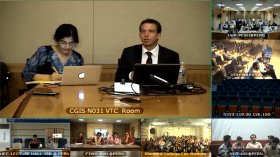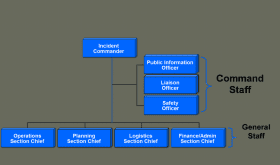South Asia is particularly vulnerable to disasters, from terrorist attacks, to floodings, to earthquakes that can affect large populations. In order to address these humanitarian crises, the fundamentals of mass casualty management are critical.
On Wednesday, October 1, SAI hosted its first webinar of the semester on disaster management with Shawn D’Andrea, MD, MPH, Instructor of Emergency Medicine, Harvard Medical School, Brigham and Women’s Hospital. With the support of SAI and the Aman Foundation, Dr. D’Andrea has been working on a project in Karachi, improving mass casualty response and disaster response for first responders, and developing hospital leadership.
Using videoconference software provided by the Higher Education Commission of Pakistan (HEC), the interactive session included participation from five universities, in South Asia, allowing around 250 students and administrators in the region to interact directly with Dr. Andrea about the fundamentals of Incident Command.
An Incident Command System (ICS) is, by definition, “a tool used for the command, control, and coordination of emergency response.” Further, it is “a set of personnel, policies, procedures, facilities, and equipment, integrated into a common organizational structure designed to improve emergency response operations of all types and complexities.”
ICS allows individuals from different organizations to work together when responding to a disaster. Dr. D’Andrea explained that ICS has a lot in common with the military, and it is based on a hierarchy. The system is used to prepare for planned events as well as unplanned disasters.
For example, Boston had an elaborate incident command system in place before the Marathon bombings of 2013. Dr. D’Andrea explained that understanding the concept is important even for those not in the medical community, in order to build awareness about what a government’s response will be to a disaster.
“But a short conversation can change that. Discussions like these [the webinar], and whatever can be done at the university level, to make the public or the students know what the authorities will do in an event of disaster response, will help the broader public understand how the disaster is managed.”
A key concept is the designation of an incident commander at the top of the hierarchy who makes decisions and coordinates the response of many individuals. The incident commander is not always necessarily the most senior individual; whoever is the most highly qualified and trained in disaster response would take this role.
Throughout the presentation, Dr. D’Andrea shared real world examples of disasters, both natural and man-made, that can serve as lessons for disaster response, including the Boston Marathon Bombings, flooding in New Orleans after Hurricane Katrina, a building collapse in New York, and bombings in Pakistan.
In his presentation, Dr. D’Andrea shared the key concepts of ICS:
- Unity of command: Each individual answers only to one supervisor, which decreases confusion with orders and increases accountability.
- Common vocabulary: Allows individuals from different agencies to communicate effectively and minimizes confusion and miscommunication. The common language should rely on clear text, not radio codes, organization-specific codes, or terminology.
- Flexible organization: The hierarchy should be adaptable based on the scale of the situation. The principles will be the same, but will fit the needs of the disaster. The system does not necessarily need to rely on advanced technology; it can be implemented based on resources available.
- Span of control: The person in control only directs the actions of a limited number of people, ideally five, which limits distractions and allows individuals to focus on their specific task.
- Management by Objective: The response operations should be organized around specific objectives, and these objectives should be prioritized.
The interest of the participants was evident during the webinar, as students and administrators in South Asia asked follow up questions about the presentation, which contributed to a dynamic and lively discussion with Dr. D’Andrea. Questions were also submitted on social media. The session demonstrated how a webinar like this one is a vital tool in the exchange and generation of knowledge.
“I think universities play an important and unique role, which is to bring these principles, which can be a bit challenging and unusual initially, and demystify them and bring them to a broader public,” Dr. D’Andrea explained. “I think the best way for that to happen is through discussion like this, and also through local experts who are doing work on the ground already. Universities are great environments to share this information.”
Participating universities included Kinnaird College For Women, Lahore, Fatima Jinnah Women University, Rawalpindi, University of Peshawar and the Centre for Disaster Preparedness and Management, University of Haripur, and NED University, Karachi. Not only did the sessionas allow these schools to interact with Harvard, they were able to interact with each other. The discussion was moderated by Erum Sattar, SJD Candidate, Harvard Law School.
The next webinar will take place on November 19, on the topic of Mass Casualty Triage with Usha Periyanayagam, MD.
Resources:
Full recording of the webinar (starting at 22:00)
FEMA National Preparedness Directorate National Training and Education


